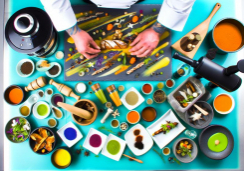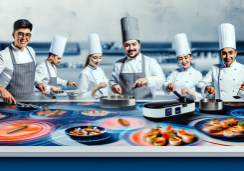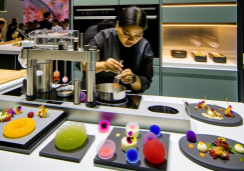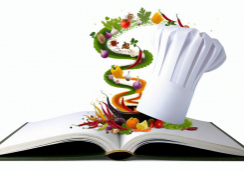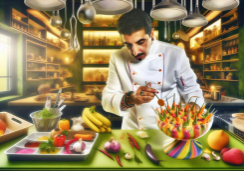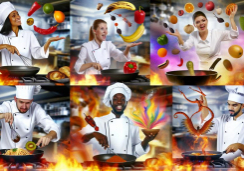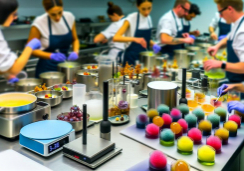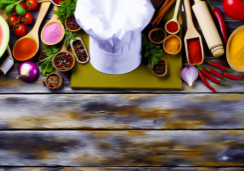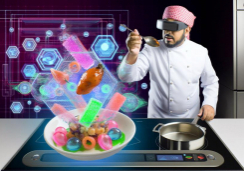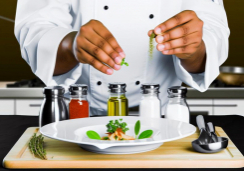10 Innovative Culinary Techniques for Creative Recipes
Imagine the sizzle of a fragrant spice as it hits the hot oil, the slow transformation of raw ingredients in a sous vide bath, and the alchemical change of liquids into delicate spheres that burst with flavor on the tongue.
You're constantly seeking to push the boundaries of what's possible in your kitchen, and the mastery of innovative culinary techniques is the key to unlocking a treasure trove of creative recipes.
With the precision of sous vide, the whimsy of spherification, and the deep flavors coaxed out through fermentation, you have the potential to craft dishes that linger in the memory long after the last bite.
As you explore these methods, each more intriguing than the last, you'll find that the artistry of cooking isn't just about following a recipe—it's about creating an experience.
Will you settle for the familiar or will you transform your culinary canvas with techniques that challenge the palate and the imagination?
Sous Vide Precision
Unlock culinary perfection by embracing Sous Vide Precision, a technique that lets you cook ingredients sealed in a plastic bag to a precise temperature, ensuring your meats are tender, flavorful, and cooked just right every time. With sous vide cooking, you wield the power of consistency, making once elusive perfectly cooked pork chops and chicken breasts an everyday reality.
By employing an immersion circulator, you maintain a precise temperature throughout the cooking process. This precision eradicates the guesswork from your cook times and guarantees that every nook and cranny of your food reaches the exact level of doneness you desire. Unlike traditional methods, where the heat source can create gradients of doneness, sous vide cooking brings your ingredients to a uniform temperature, ensuring even cooking from edge to edge.
The vacuum-sealed bag locks in the natural flavors and juices of your food, intensifying them as they cook. This not only preserves the integrity of your ingredients but also enhances their inherent qualities, delivering a taste experience that's both pure and profound.
Sous vide's meticulous temperature control translates into unparalleled culinary results. It's not just cooking; it's an innovative way to bring precision and efficiency to your kitchen, elevating your dishes to works of art.
Spherification Magic
While sous vide precision offers unparalleled consistency in cooking, Spherification Magic invites you to transform liquids into captivating spheres that burst with flavor, adding a touch of culinary sorcery to your repertoire. This technique, a hallmark of molecular gastronomy, isn't just about wowing your guests with visual marvels; it's about redefining the boundaries of Modernist Cooking and expanding your culinary artistry.
Here's how you can delve into the world of Spherification Magic:
- Understand the Chemistry: Grasp the reaction between calcium chloride and sodium alginate to create the perfect gel membrane.
- Master the Technique: Practice dripping your flavored liquid into the calcium bath with precision to form uniform spheres.
- Play with Flavors: Experiment with a variety of juices, broths, or spirits to add surprising bursts of flavor to your dishes.
- Presentation is Key: Use spherification to add an innovative twist to desserts, cocktails, and savory dishes, enhancing both the aesthetic and the taste.
Flash Freezing Techniques
As you explore the transformative power of flash freezing, you'll discover its ability to lock in flavors and textures, ensuring that your culinary creations are as fresh-tasting as the moment they were made.
You'll find this technique indispensable for delicate ingredients that require preservation without compromising quality, from sauces to foams.
Mastering flash freezing opens up a world of possibilities, allowing you to push the boundaries with innovative presentations and unexpected textural contrasts.
Benefits of Flash Freezing
Delving into the realm of flash freezing, you'll discover that it's a pivotal technique for preserving the integrity of your favorite foods, safeguarding their texture, color, and flavor by rapidly chilling them to sub-zero temperatures.
Here's how you can reap the benefits:
- Quality Preservation: Flash freezing with liquid nitrogen prevents large ice crystals, ensuring your perfectly cooked meals maintain their quality.
- Nutrient Retention: The quick and easy process locks in vitamins and minerals, so dishes remain as nutritious as they're delicious.
- Shelf Life Extension: Foods last longer without compromising taste, giving you more flexibility with your culinary creations.
- Convenience: Prepare and preserve in advance, allowing for efficient meal planning and the enjoyment of seasonal produce year-round.
Common Flash Freezing Applications
Building on the benefits of flash freezing, let's explore the common techniques that transform ordinary ingredients into extraordinary culinary masterpieces.
In molecular gastronomy, chefs often use an anti-griddle, chilling the surface to a brisk -30 degrees Fahrenheit to rapidly solidify sauces, foams, and purees. This precision in temperature control allows for the creation of intricate, visually stunning components that maintain their shape and texture.
Liquid nitrogen, another flash freezing tool, instantly freezes food with minimal water content alteration, preserving the quality and freshness.
Fermentation Flavors
You're entering the realm of fermentation, where culinary creativity meets science to transform flavors.
Mastering fermentation basics, you'll coax out tangy, rich, and complex profiles from simple ingredients.
As you explore flavor enhancement techniques, you'll unlock aromatic dimensions that can elevate your dishes to new heights.
Fermentation Basics
Embarking on the journey of fermentation unlocks a world of flavors, transforming ordinary ingredients into culinary treasures with rich, complex profiles. Here's how you can dive into fermentation basics to expand your cooking techniques and deepen your understanding of food:
- Explore Lacto-Fermentation: Utilize good bacteria to create tangy, probiotic-rich foods like sauerkraut and kimchi.
- Experiment with Wild Fermentation: Capture natural yeasts for unique flavors in homemade sourdough or fermented beverages.
- Understand Flavor Development: Recognize how time and temperature influence the acidity and savory notes of your ferments.
- Incorporate New Techniques: Integrate fermented ingredients into your recipes to add depth and complexity that'll impress any palate.
Master these principles, and you'll craft innovative dishes that resonate with the essence of culinary artistry.
Flavor Enhancement Techniques
As you delve into the realm of fermentation, you'll discover that this age-old technique not only preserves foods but also significantly elevates their flavors, imparting a complexity that can transform your culinary creations.
By incorporating herbs into your ferments, you unlock a tapestry of nuanced tastes.
Fermentation isn't only about tradition but also precision and control. With a vacuum sealer, you can create an anaerobic environment ideal for fermenting, ensuring consistent results every time.
This method allows the natural bacteria to thrive, producing those distinctive, tangy notes and rich probiotics that are as beneficial to your health as they're to your palate.
Embrace this sustainable flavor enhancement technique and watch as your dishes acquire an unmatched depth and vibrancy.
Modernist Foams
Often transforming the ordinary into the extraordinary, modernist foams employ innovative techniques to infuse dishes with unexpected textures and nuanced flavors. In your cutting-edge kitchen, you'll find that these foams, a hallmark of molecular gastronomy, offer a playground for creativity and sensory delight.
Here's how you can master modernist foams:
- Invest in a Siphon: Get yourself a quality siphon whipper and nitrous oxide cartridges. This tool is essential for creating light, airy foams that can top a variety of dishes.
- Experiment with Flavors: Don't shy away from bold combinations. Modernist foams can carry intense flavors, such as truffle or fruit essences, adding a new dimension to your culinary creations.
- Refine Your Technique: Practice techniques like sous vide to infuse your foams with deep, consistent flavors. Precision cooking methods contribute to the stability and texture of your foams.
- Presentation Matters: Use foams to add visual interest to your dishes. Their unique structure can be a canvas for plating artistry, elevating the aesthetic appeal of your recipes.
Charcoal Infusions
While modernist foams can elevate the sensory experience of your dishes, integrating charcoal infusions will introduce a bold smokiness that's hard to replicate with other methods. As you explore new cooking methods, consider how activated charcoal can transform your culinary creations.
This potent powder is celebrated not only for its detoxifying properties but also as a natural coloring and flavoring agent that can add a dramatic touch to your plate.
Charcoal-infused cocktails, ice creams, and baked goods are edging into the limelight, enticing adventurous palates with their distinctive appearance and complex flavor notes. Techniques that are commonly used may not suffice when you're aiming to push the boundaries of traditional tastes.
By incorporating food-grade activated charcoal into liquids or using it as an integral part of your ingredients, you open up a world where the depth of earthy tones meets visual intrigue.
To ensure your charcoal infusions are both safe and palatable, it's crucial to control the quantity precisely. Too much can overwhelm your dish, masking the delicate balance you're striving for. Remember, with great power comes great responsibility.
Use charcoal responsibly to unlock a spectrum of innovative possibilities in your culinary repertoire.
Pressure Cooking Mastery
As you embrace the art of pressure cooking, you'll unlock a world where tender meats and vibrant stews materialize in moments, not hours.
Grasping the fundamentals of your pressure cooker ensures you're equipped to safely harness the power of steam and pressure.
Let's elevate your culinary repertoire by exploring advanced techniques that turn ordinary ingredients into extraordinary experiences.
Pressure Cooker Fundamentals
Mastering the pressure cooker's steam-driven efficiency will revolutionize your culinary repertoire with quick-cooking techniques that preserve the robust flavors and nutrients of your ingredients. This method of cooking, harnessed by a staple in kitchen tools and equipment, the pressure cooker, allows you to delve into a world where time is no longer a barrier to wholesome meals.
Here are four fundamental tips to get you started:
- Always check the seal and valves for safety before use.
- Don't overfill the cooker; leave space for steam accumulation.
- Use sufficient liquid to create steam, but not too much to dilute flavors.
- Adjust traditional cooking times—pressure cooking is much faster.
Advanced Pressure Cooking Techniques
To elevate your culinary creations to new heights, it's essential to delve into advanced pressure cooking techniques that unlock complex flavors and textures with remarkable speed.
Embrace the precision of Sous Vide within your pressure cooker to achieve evenly cooked results that were once the exclusive domain of high-end restaurants. By sealing your ingredients and submerging them at the perfect temperature in water, you ensure consistent, mouth-watering tenderness across dishes like pork chops and chicken breasts.
Infuse your meats and vegetables with depth by adding herbs directly into the pressure cooker; this innovative approach marries the robustness of pressure cooking with the subtlety of flavor layering.
Master these techniques to stay ahead in the competitive culinary industry, constantly pushing boundaries and dazzling your customers with your expertise.
Low-Temperature Baking
Delve into the nuanced world of low-temperature baking, where you'll discover how gentle heat can transform simple ingredients into exquisitely tender creations. This technique, akin to the precision of Sous Vide, allows chefs to create dishes that aren't only tender and flavorful but also boast an unparalleled texture and consistency.
Here's how you can master the art of low-temperature baking:
- Embrace Patience: Extend your baking times while keeping temperatures low to ensure even cooking without over-browning.
- Moisture Retention: Benefit from the moisture-rich environment that low-temperature baking provides, keeping your creations succulent.
- Flavor Preservation: Capture the natural flavors of your ingredients, as the gentle heat prevents the loss of delicate aromas.
- Monitor and Adjust: Keep a vigilant eye on your oven's temperature and adjust the baking times accordingly to achieve the perfect doneness.
This innovative approach to baking pushes the boundaries of traditional techniques. By controlling the heat with precision, you're able to coax out the best qualities of your ingredients, making every bite a testament to your culinary prowess.
Low-temperature baking isn't just about following a recipe—it's about engaging with your food on a level that ensures each dish is a masterpiece of flavor and texture.
Deconstructing Classics
Building on the meticulous control of low-temperature baking, deconstructing classics invites you to dissect time-honored recipes and inject a burst of creativity into each component. This approach demands not just a reverence for the original but also the courage to transform it, employing innovative culinary techniques such as Sous Vide and the principles of molecular gastronomy.
As you deconstruct a classic, you're diving deep into its essence, exploring each flavor and texture. Your task is to unravel the threads of tradition and weave them into a tapestry that surprises and delights. Imagine taking apart a beloved beef wellington and serving it as a tender Sous Vide fillet, a dollop of duxelles foam, and a crisp pastry tuile. You've maintained the core identity of the dish while presenting it in a way that challenges and excites the palate.
Deconstructing classics isn't just about changing a dish's form; it's about redefining its very substance. It's a meticulous process that requires a profound understanding of the ingredients and the methods that bring them to life. Whether you're breaking down the components of a Caesar salad or reconstructing a lasagna, your goal is to honor the original while crafting an entirely new experience.
This is where your skill shines, marrying tradition with innovation to create culinary masterpieces that resonate with a modern audience.
Smoke and Aromatics
Infusing your dishes with smoke and aromatic elements can elevate them from delicious to unforgettable, adding a dimension of flavor that tantalizes the senses. As you delve into molecular gastronomy or simply seek to refine your culinary repertoire, don't overlook the transformative power of smoke and aromatics. When you harness these techniques, you're not just cooking; you're orchestrating a symphony of taste and aroma.
Here are four innovative ways to incorporate smoke and aromatics into your dishes:
- Cold Smoking for Delicate Flavor: Utilize cold smoking to impart a gentle smoky essence to cheeses, vegetables, or even cocktails without altering their texture. Chefs are able to achieve this subtlety by keeping the food at a low temperature, away from direct heat.
- Aromatic Wood Chips: Choose from woods like hickory, apple, or mesquite to bestow a distinct smokiness that complements your dish's primary ingredients.
- Herb and Citrus Infused Smoke: Elevate your smoke by adding herbs, spices, or citrus peels to your smoking chips, thereby infusing your food with intricate layers of flavor.
- Sous Vide and Smoke: Combine sous vide precision cooking with a post-bath smoke session for proteins that are perfectly tender, moist, and rich with a smoky profile.
Conclusion
You've now unlocked the secrets of culinary innovation.
Embrace sous vide for impeccable texture, dazzle with spherification's whimsy, and master flash freezing for instant chill.
Cultivate rich flavors through fermentation, create ethereal foams for a sensory surprise, and expedite with pressure cooking.
Experiment with low-temp baking for nuanced tastes, deconstruct classics to intrigue the palate, and infuse dishes with smoke for depth.
Your kitchen's transformed; a playground for creativity, efficiency, and flavor excellence.
Cook boldly, the future's in your hands.

